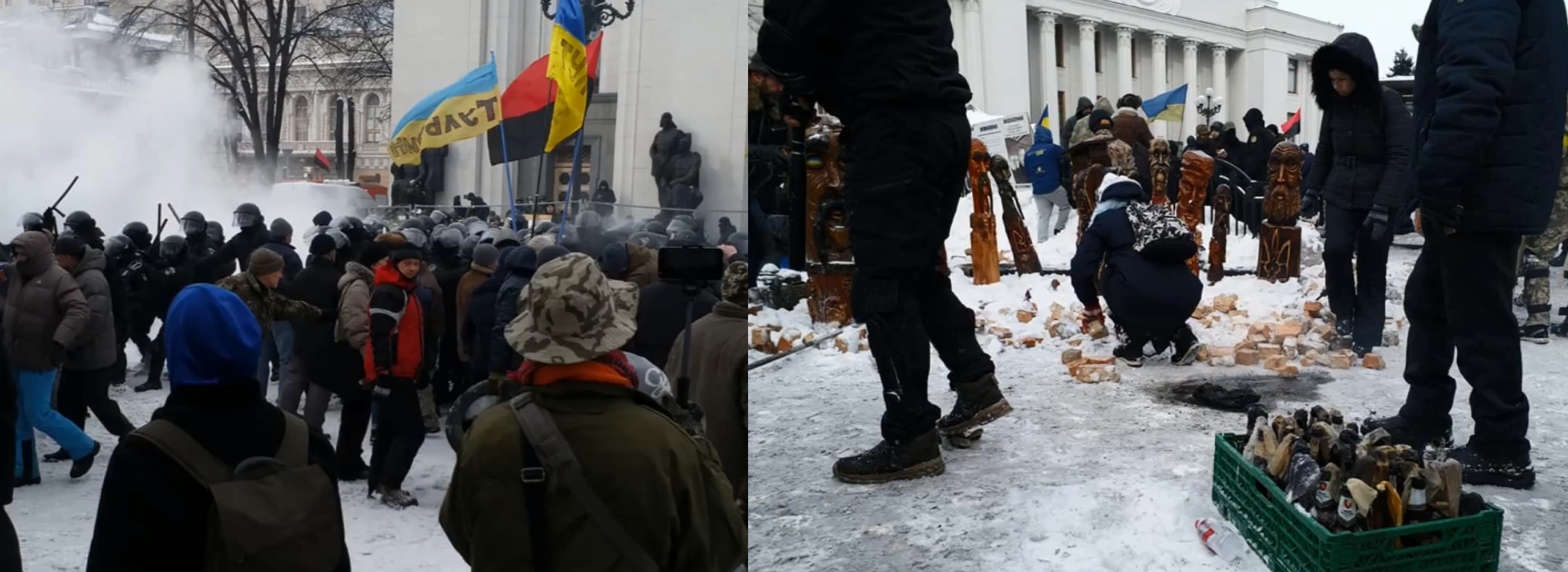Rada Protests and Police Action
How violence erupted in front of the Ukrainian parliament on February 27
Rada Protests and Police Action

How violence erupted in front of the Ukrainian parliament on February 27

On March 3, Ukrainian riot police cleared a tent camp and arrested over 100 protesters in front of the Verkhovna Rada, the Ukrainian Parliament. During a search of the camp, the authorities claimed to have found hand grenades, Molotov cocktails, and smoke bombs. Prior to this incident, on February 27, thirteen policemen suffered injuries of varying severity during protests in front of Ukraine’s Verkhovna Rada in Kyiv. This occurred during skirmishes that pitted a sizable riot police force against a smaller but determined force of protesters — which hurled tires, Molotov cocktails, small explosive devices and more at law enforcement.
The protests came as pressure mounted on Ukrainian President Petro Poroshenko, who has become increasingly controversial in the eyes of a public weary from the long-winded reform process.
News media was quick to point out that the protests were provocations organized by the political movement “New Forces”, founded by former President of Georgia Mikheil Saakashvili, a key figure in Ukrainian politics. Relations between Saakashvili and Poroshenko are strained to say the least, with the two parties exchanging accusations of corruption. Ukrainian authorities recently deported Saakashvili to Poland after being stripped of his short-lived Ukrainian citizenship in 2017.
On the day of the incident, a video was posted detailing incidents of protesters throwing objects at police, including small firework-like explosives. Conveniently, many protesters engaging in such activity all wore patches that allowed for their identification.
The patches worn by some of the unruly protesters read “Defensive Forces of Ukraine” (Сили оборони України). The vast majority of people wearing the patches wore them on their left arm, with the right arm reserved for Donbas Battalion or “Donbas Battalion Internal Corps” (Внутрішній Корпус Батальйону Донбас) patches. Donbas Battalion, now a national guard unit, was one of the original volunteer battalions from 2014. As with other volunteer battalions, veteran networks formed around Donbas Battalion make for powerful political mobilization tools.

The scene of the incident was at a tent camp erected in front of the Rada in October. Semen Semenchenko, former battalion commander of Donbas and now deputy of the Ukrainian Rada, has been highly active in the camp of indignant veterans.
The Defensive Forces of Ukraine is likely a joint venture in activism between the Samopomich (“Self Reliance”) party’s Semenchenko and the “Liberation” (Визволення) movement. The liberation movement is an organization comprised of Ukrainian veterans, striving to rid the country from corruption. A scan of the official “Liberation” Movement Facebook page shows that a significant amount of posts either involve Semenchenko or “Liberation” members wearing Donbas and Defensive Forces of Ukraine insignia. In fact, as of March 2, 15 out of 35 Facebook posts since February 25 involved Semenchenko or related insignia.
On February 26, the official “Liberation” Facebook page posted an announcement that activists from Transcarpathia (western Ukraine) would be holding a demonstration the following day, inviting anyone interested to join them. What’s more, on the day following the incident, the movement made a post describing the detention, and subsequent release, of six of their members on February 27.

Two of the four individuals caught in the video throwing objects other than snow at police were within reasonable doubt with the Defensive Forces of Ukraine. These two individuals both threw some sorts of explosive sticks, while the other two were throwing Molotov cocktails, albeit poorly functioning ones. One of the men throwing Molotov cocktails bears a high similarity to a man standing behind “Liberation” activist and Aidar battalion volunteer Nikita Kashintsy in a video depicting protesters receiving medical aid. The man in question is also wearing Aidar insignia.

Although complete confirmation is impossible, the two men bear strong similarity to each other both in insignia, clothing, build, and stance. Another group providing support to protesters struck by police batons was RPS — Revolutionary Right Forces (Революційні Праві Сили). RPS is another, albeit smaller, Ukrainian Nationalist organization. Despite its name suggesting a radical right alignment, and many of its members originating from nationalist militias, RPS claims not to be a political organization.
RPS posted a video on February 17 of their members entering and vandalizing an e-gambling parlor before fleeing the scene by car. The day after this video was published, Ukrainian Nationalists damaged a number of Russia-linked businesses, although it was unclear whether the events were linked in any way. RPS was not seen engaging in violence during the February 27 protest.

The picture on the left depicts a crate of Molotov cocktails with people digging up cobblestones in the background. Since the incident on February 27, Semenchenko posted another video to his facebook showing activists digging up more cobblestones, presumably to be used against riot police.
Conclusions
It was unclear whether Saakashvili or his civil society movement was behind the protests on February 27. What is clear, however, is that a number of different organizations were present at the time. Furthermore, deputy of the Verkhovna Rada Semen Semenchenko and the “Liberation” movement played a key part in violent altercations with police.
Follow along for more in-depth analysis from our #DigitalSherlocks.

